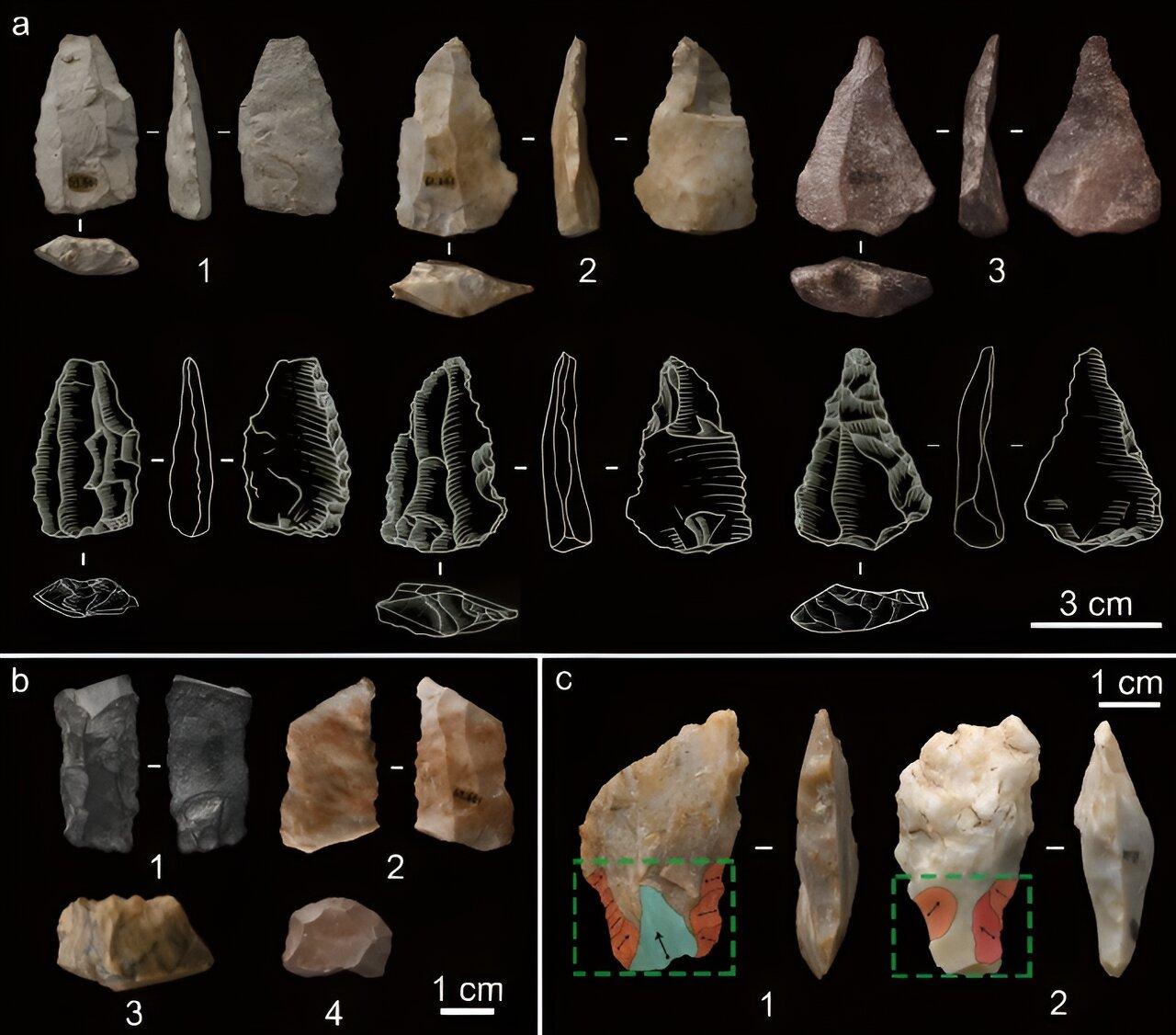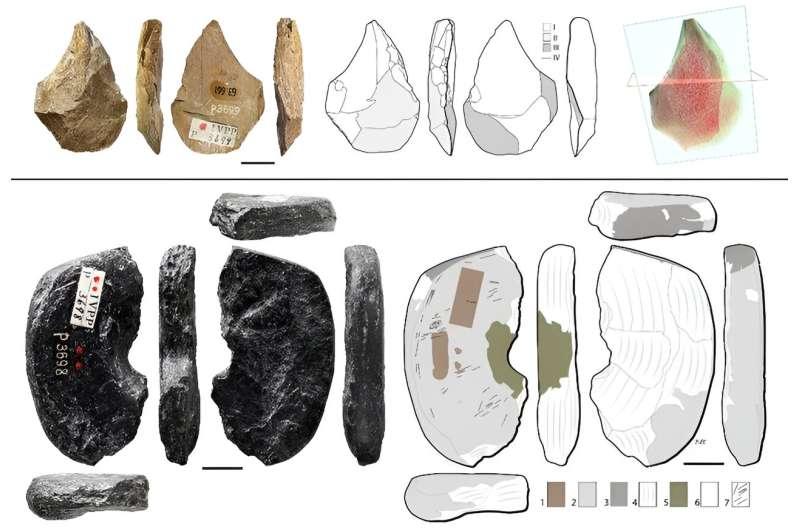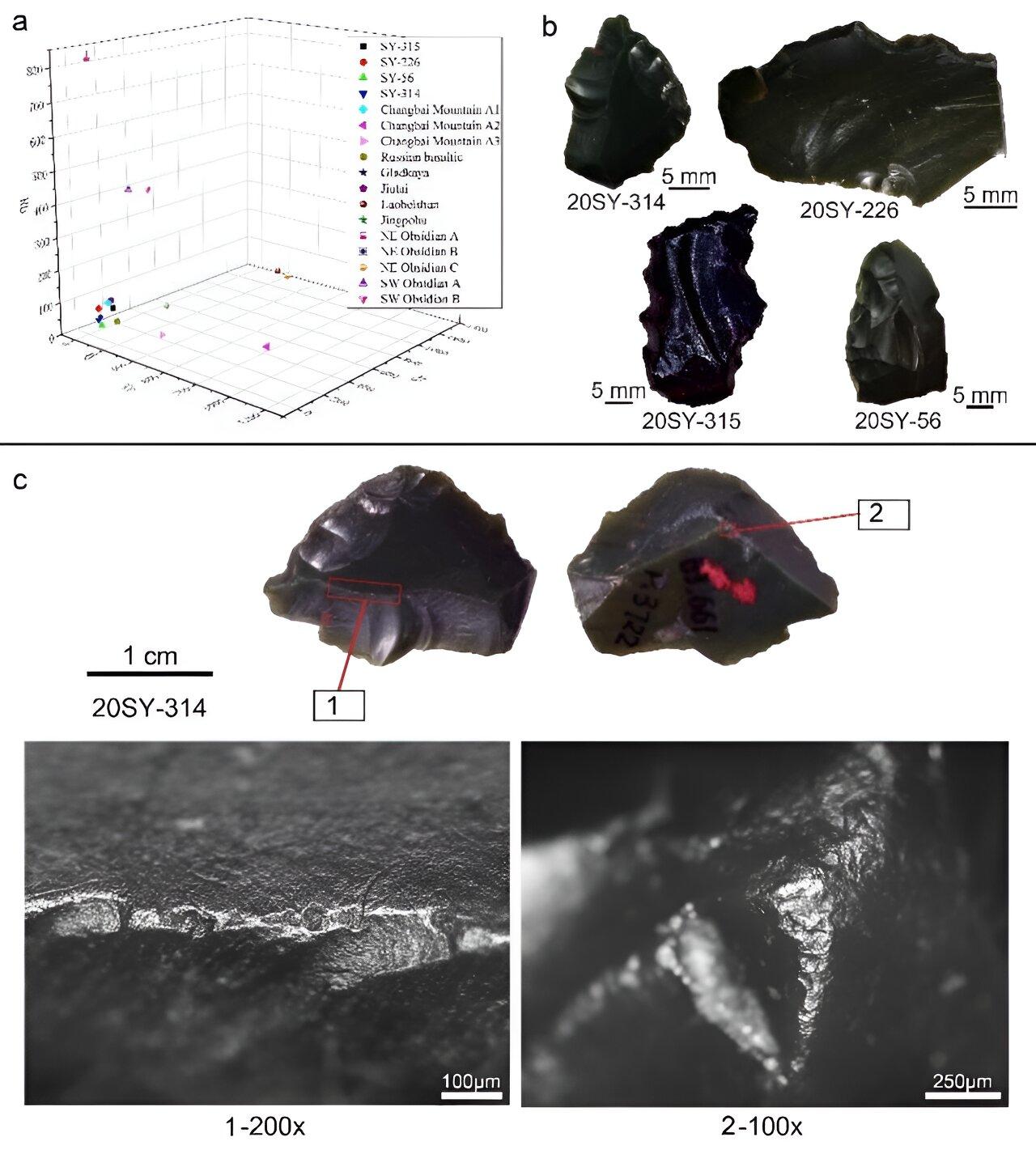Chinese Academy of Sciences
Source - https://phys.org/news/2024-01-shiyu-discovery-reveals-east-asia.html
 a) Levallois points (1–3); b) other tool types including denticulate on blade (1, 2), denticulate on flake (3), and end scraper (4); c) tanged tools showing the locations of notched retouching (red) and thinning of the tangs (light blue). Credit: IVPP
a) Levallois points (1–3); b) other tool types including denticulate on blade (1, 2), denticulate on flake (3), and end scraper (4); c) tanged tools showing the locations of notched retouching (red) and thinning of the tangs (light blue). Credit: IVPP
A team of researchers from China, Australia, France, Spain, and Germany has revealed advanced material culture in East Asia dating to 45,000 years ago. The new study is published in Nature Ecology & Evolution.
The researchers examined a previously excavated archaeological collection from the Shiyu site, located in Shanxi Province.
"Our new study identified an Initial Upper Paleolithic archaeological assemblage from the Shiyu site of North China dating to 45,000 years ago that includes blade technology, tanged and hafted projectile points, long-distance obsidian transfer, and the use of a perforated graphite disk," said associate Prof. Yang Shixia, first and corresponding author of the study and a researcher at the Institute of Vertebrate Paleontology and Paleoanthropology (IVPP) of the Chinese Academy of Sciences (CAS).
This discovery uncovered a treasure trove of cultural and technological innovations. Together with the recovery of a now-lost human cranial bone, it sheds light on the ancient migration of Homo sapiens into East Asia around 45,000 years ago.

Graphite disc and bone tool. Credit: IVPP
The researchers dated three animal bone samples recovered during the original 1963 excavation, and these were shown to be humanly modified as indicated by cut marks. Radiocarbon methods precisely dated the main cultural layer of Shiyu to between 45,800 and 43,200 years ago.
Integrated scientific studies on the archaeological findings at Shiyu revealed an advanced material culture dating to 45,000 years ago. This includes Levallois points, tanged and hafted projectile points with evidence of impact fractures, long-distance transfers of obsidian from sources hundreds of kilometers away, a perforated graphite disk, and well-shaped bone points.
The results of the taphonomic analysis of the mammal fossils, combined with use-wear analysis of the stone tools, indicated that the Shiyu inhabitants were "horse hunters" equipped with tanged and hafted projectile points, thus having the ability to hunt and selectively cull adult equids.
Shiyu provides us with an opportunity to look into the life of the skillful hunters from northern China 45,000 years ago. The people inhabiting the region had a remarkably advanced tool kit, with a range of innovative tools from the Upper Paleolithic, including end-scrapers, awls, and tools of former times, including Middle Paleolithic Levallois points, various tanged tools, denticulates, and borers.
 Reconstruction of Shiyu "horse-hunters" Credit: Guo Xiaocong
Reconstruction of Shiyu "horse-hunters" Credit: Guo Xiaocong
 a) scatterplot of Rb, Sr, and Zr measurements for the Shiyu obsidian artifacts and obsidian sources across East Asia; b) the four obsidian lithics from Shiyu; c) SY20-314 endscraper on obsidian. 1–2, transport wear observed at 200x and 100x magnification. Credit: IVPP
a) scatterplot of Rb, Sr, and Zr measurements for the Shiyu obsidian artifacts and obsidian sources across East Asia; b) the four obsidian lithics from Shiyu; c) SY20-314 endscraper on obsidian. 1–2, transport wear observed at 200x and 100x magnification. Credit: IVPP
The unique set of stone tool artifacts, in combination with the shaped graphite disk and bone tools, shows that early peoples had a rich culture. The long-distance transport of obsidian from sources hundreds of kilometers away also indicates advanced and long-distance resource procurement strategies and migration abilities.
Shiyu reflects a process of cultural creolization—through contact between societies and relocated peoples—whereby inherited traits blended with novel innovations, thus complicating the traditional understanding of Homo sapiens' global expansion.
More information: Nature Ecology & Evolution (2024). DOI: 10.1038/s41559-023-02294-4